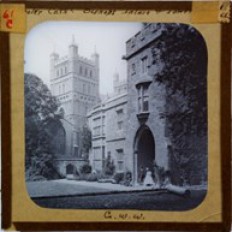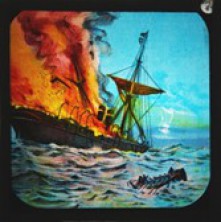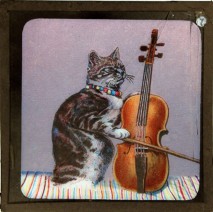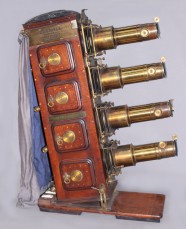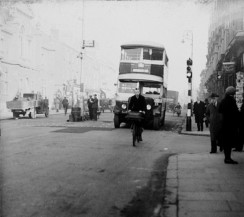
The Magic Lantern
Views of the local, views of the far away
with Dr Richard Crangle on Thursday, 8 February 2024
at 7pm Southernhay United Reform Church, Garden Room
Our speaker has a PhD in early film and related media and has been researching magic lantern slides for over thirty years, with a particular focus on British commercial slide manufacture of the late 19th and early 20th centuries, is co-editor of The Encyclopaedia of the Magic Lantern (2001), Realms of Light (2005), and Screen Culture and the Social Question 1880-1914 (2014), and author of numerous articles and conference papers.
His plan for the talk was to use the actual magic lantern he brought with him, but lack of space in the room we were in dictated that it was necessary to show his talk via his laptop and display the magic lantern for the audience to appreciate. He explained that a magic lantern was simply a box with an oil burner, a lamp, reflector and lens to show an image.
His talk covered three main areas:
- Hardware
- Images
- People
Richard explained that the ways magic lanterns were used was different in relation to which audience the slides were shown to. There are examples of magic lanterns in museums. The first known one was 1659 but there may have been ones earlier than this. An early version was a light inside a box and evolved into a slide projector and then became digital. The earliest magic lanterns were lit by an oil burner and had a chimney to prevent a hole letting out light.
Richard gave an example of a toy lantern to show children. Magic lanterns were used in Sunday schools and any institution would have had one in the late 19th century.
Richard’s own lantern was made of mahogany with a brass lens and had a fancy chimney and had its own wooden box with “Devonport Camera Club” written on the outside and was probably made in London.
He showed images of lanterns with two lenses which were known as bi-unials which could toggle between two different slides, tri-unials with three lenses, and one with four lenses made in 1897 which was used up until 1961 then mysteriously lost until two years ago when it popped up at auction and sold for £30,000, (bought by a friend of Richard’s) It was known as Noakes Quadruple Lantern. He went on to explain the different modifications – arc light, bulbs, limelight burners and the limes (cylinders) which glow when hot enough. This is the origin of “limelight” in the theatre which uses a supply of oxygen and hydrogen which can be very dangerous. Richard showed an example of a wooden holder sold by Hinton Lake of Exeter to move images from side to side and also of a small LED lamp as used today.
People, often pedlars, travelled around the country giving shows. Some early 19th century shows were known as Fantasmagoria – ghostly images, where lanterns moved images backwards and forwards making them suddenly appear as if by “magic”. Some were intended as educational shows, some as political satire, and some using two pieces of glass in the slide to show movement – of animals’ eyes as in an example of Noah’s Ark, a dancing sailor, and one of a horse appearing to move its head in order to drink water. Another more sophisticated example showed an image of a scene in summer then changing to winter, and animated movement.
Richard explained that there were actually three standard sizes of slides – British, US and European. Photographic views in sets of a specific number were shown to audiences of places like Africa, India and the USA Chicago Exhibition of 1893. Some were used as religious or temperance propaganda. They were black and white photos with hand-painted colour added. Another example Richard showed were from a set called White Slaves of London – posed photos showing a story. One interesting photo was of a house somewhere called Chapel Street and painstaking research revealed that the house was actually in a suburb of Cambridge with a modern photo to prove it. There were adverts of shops – W.R. Lisle & Sons at 179 Fore Street, Exeter, B. Brown & Sons at 40 (or 42) High Street, Exeter in the 1920s, Cornish’s, H.J. Escott, Baker & Confectioner at 109 Cowick Street, Wannell’s at 147 Fore Street, Exeter showing an African caricature which today would be regarded as a racist image. Richard finished by showing some very detailed photographic slides, which had been scanned for him by Peter Thomas, of Sidwell Street at its junction with Summerland Street, an Exeter Corporation Bus, Cathedral Yard, a post-War image of Exeter showing a funfair on what became Princesshay, Heavitree from the air, and the Cathedral and city centre before the War.
It was a fascinating talk by a very interesting speaker which prompted many questions by our members and an evening greatly enjoyed by all those present.
Thank you to Richard for the help with the write up and for supplying the images, and to Sue Jackson for her excellent note taking.
[ Judith Hosking ]
